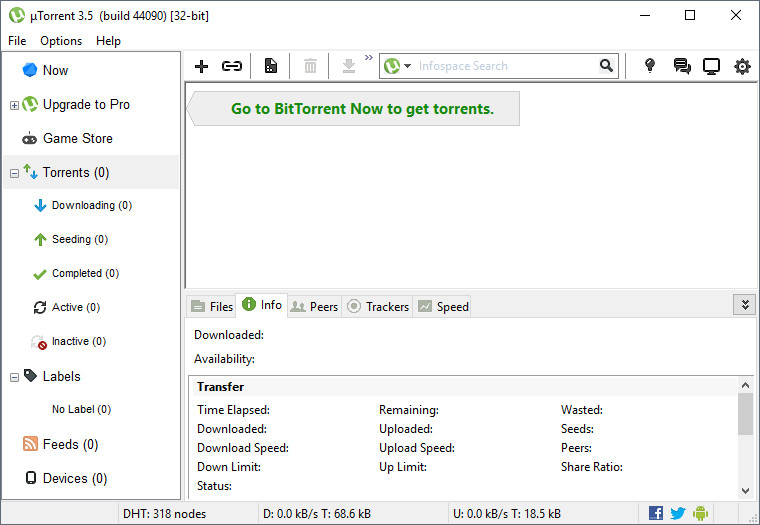µTorrent stands out as a highly efficient and feature-rich BitTorrent client designed specifically for Windows. It prioritizes a minimal resource footprint while delivering the full functionality expected from advanced torrenting applications. Built with efficiency in mind, µTorrent avoids consuming excessive CPU or memory resources, enabling users to run other tasks on their computer with little to no impact. The client is compact by design, typically using less than 6 MB of memory, which helps keep system responsiveness intact even during intensive torrenting sessions. In addition, the program is packaged within a single executable file that weighs in at under 3.0 MB, contributing to its portability and ease of distribution. This combination of low memory usage and a tiny executable makes µTorrent particularly well-suited for older hardware or systems with limited resources, allowing seamless multitasking alongside torrent downloads.
The Core Philosophy: Efficiency and a Tiny Footprint
µTorrent’s development philosophy centers on delivering robust torrenting capabilities without compromising system performance. The designers aimed to provide a comprehensive set of features found in larger, heavier clients while maintaining a frugal footprint on CPU, memory, and disk space. This balance between feature richness and resource efficiency is a defining trait of µTorrent, enabling it to operate in the background with minimal disruption to other applications and user activities. By emphasizing a small memory profile—commonly under 6 MB—and a compact, single-file distribution under 3 MB, the software demonstrates that high performance need not come at the expense of system responsiveness. Users running contemporary tasks such as gaming, video editing, or large spreadsheet analyses can still rely on µTorrent for torrent management without experiencing noticeable slowdowns or resource contention.
The efficiency of µTorrent also translates into quicker startup times and reduced background activity, which impact overall user experience. A BitTorrent client with a lightweight footprint can run alongside other demanding software with limited interference, enabling smoother multitasking. The design choices that enable such efficiency include careful thread management, lean networking logic, and a modular approach that prioritizes essential functionality while avoiding unnecessary bloat. Although µTorrent is described as feature-rich, its resource-conscious architecture ensures that even with an extensive feature set, the client remains unobtrusive on Windows systems. This thoughtful balance between capability and economy is central to the user experience for both casual downloaders and power users who demand reliable performance across diverse workloads.
From a user onboarding perspective, the lightweight footprint reduces the perceived friction associated with adding torrenting to a workstation or home PC. New users can install and configure the client quickly, observe minimal impact on system performance, and begin managing downloads promptly. This is particularly advantageous for users with older devices, limited RAM, or those who run multiple applications simultaneously. The result is a flexible and dependable torrenting tool that remains responsive under varied network conditions and during long-running downloads. In short, the core philosophy of µTorrent is to deliver a powerful, capable BitTorrent client while preserving the smooth operation of the host computer through disciplined resource usage.
Technical Profile and Packaging
µTorrent’s technical profile reflects deliberate choices that optimize performance without sacrificing essential features. The client is designed to be compact in both code size and runtime resource consumption, with a memory footprint that typically stays below 6 MB during operation. This low memory usage is a key differentiator in the crowded field of BitTorrent clients, where resource demands can vary widely between products. By maintaining a small memory footprint, µTorrent minimizes paging and caching overhead, which can be especially beneficial on systems with constrained physical memory or during concurrent workloads.
Another defining attribute is the packaging approach: the entire program is contained within a single executable file, with a size under 3 MB. This architecture simplifies distribution, deployment, and updates, and reduces the risk of missing dependencies that sometimes plague larger installers. A single-file design also enhances portability, making it easier to carry a compact torrenting tool between devices or store it on a USB drive for quick access on different Windows machines. The reduced footprint contributes to faster startup, quicker initialization of torrent sessions, and more predictable performance across various hardware configurations.
The combination of a small, self-contained package and a deliberately efficient runtime footprint has broader implications for system stability and user experience. For Windows users, this means a torrent client that can run without dominating system resources, leaving more headroom for other tasks, such as productivity software, media playback, or gaming. The technical strategy behind µTorrent demonstrates how thoughtful engineering can deliver a comprehensive feature set without compromising the integrity of the operating environment. In practical terms, users can expect snappy launch times, steady performance during downloads, and a straightforward, low-overhead experience that reduces the likelihood of bottlenecks caused by the torrent client itself.
Packaging and distribution considerations
The single-executable packaging model reduces clutter on the user’s system and simplifies software management. Without multiple DLLs or auxiliary installers, users face fewer compatibility issues and faster installation processes. This streamlined approach also helps with maintenance and updates, as the updater logic can target a contained file rather than a sprawling installation tree. From a security and reliability standpoint, the compact architecture makes it easier to audit and verify the integrity of the software, since there is a smaller surface area for potential issues. While feature parity with larger clients is a common expectation, µTorrent’s packaging strategy demonstrates that a well-designed, efficient product can offer a comprehensive set of tools without unnecessary complexity.
According to the design goals, the software remains suitable for devices with limited disk space or low-power configurations. The combination of a tiny executable and a small runtime footprint translates into faster installation, quicker launches, and less disruption during system updates or performance-sensitive tasks. For enterprise environments or schools that manage a fleet of Windows machines, this level of efficiency can contribute to improved resource allocation and lower maintenance overhead. Overall, the technical profile and packaging choices reinforce µTorrent’s identity as a lightweight, reliable, and portable BitTorrent client that emphasizes performance, simplicity, and practical usability.
Version 3.5.5 Build 45704: Changelog Status and Release Context
The latest noted version in the provided material is µTorrent 3.5.5 Build 45704. At the time of the available information, the changelog for this specific build was not yet published or accessible. This absence of a publicly posted changelog means readers and users may not have a detailed, official record of bug fixes, feature adjustments, or performance improvements associated with Build 45704. Nonetheless, the absence of a formal changelog does not preclude the practical value of the release, as the core characteristics of µTorrent—its efficiency, compact footprint, and feature-rich design—remain applicable and relevant to users evaluating the software for Windows environments.
In addition to release notes, the download size for this build is indicated in the source material. The entry references a download size of 4.8 MB for the available freeware version, which reflects the typical packaging of a compact BitTorrent client intended for Windows users who seek a balance between performance and accessibility. Acknowledging the ongoing development cycle, users can anticipate that updates to the software may introduce enhancements, refinements, or security improvements, even when a formal changelog is temporarily unavailable. The absence of a listed changelog underscores the importance of independent testing and user feedback in assessing the real-world impact of a new build.
From a practical standpoint, Windows users evaluating 3.5.5 Build 45704 should consider their typical torrenting needs, hardware capabilities, and preferred configuration. While the changelog may not be immediately visible, the fundamental attributes of µTorrent—its small memory footprint, compact executable, and overall efficiency—remain reliable indicators of expected performance. For users who rely on consistent download throughput, stable background operation, and a minimal resource footprint, the available information suggests that this build continues to align with the established strengths of the µTorrent platform.
Release cadence and expectations
Understanding release cadences for BitTorrent clients helps users plan upgrades, compatibility, and security considerations. In scenarios where changelogs are not immediately visible, users typically verify the stability and performance through practical use, community discussions, and general reputation for reliability. For µTorrent, the combination of a lean footprint and a feature-rich design has historically appealed to Windows users who require a dependable torrenting tool without sacrificing system resources. While official changelog dissemination is useful for precise details, the enduring value proposition of µTorrent remains centered on efficient operation, fast startup, and robust torrent management capabilities.
Setup Considerations: Optional Third-Party Software
A notable note surrounding the installation process of µTorrent is that the setup can include optional third-party software. This means that during installation, users might encounter offers or prompts to install additional components that are not essential to µTorrent itself. This practice, common among several software packages, can introduce extra software into a system if users do not deselect the optional components. For users prioritizing a clean Windows environment and minimal software footprint, it is important to carefully review installation screens and opt out of any non-essential third-party applications. The presence of optional software does not imply a deficiency in µTorrent; rather, it reflects a broader packaging approach that some installers use to bundle ancillary tools. As with any software installation, choosing a custom installation path and reviewing the component list can help ensure that only the desired elements are installed.
From a user experience perspective, this setup consideration reinforces the importance of user awareness during initial installation. A straightforward, informed installation choice preserves privacy, system resources, and security posture by avoiding the unintended introduction of additional software. For Windows users who value a lean software environment, it is advisable to select custom installation options when prompted and to deselect any adjacent offerings that are not directly related to the core torrent client functionality. This approach aligns with the overall philosophy of µTorrent: a powerful, efficient BitTorrent client delivered in a compact, easily managed package.
In practice, users who successfully navigate the setup without enabling optional third-party software can begin using µTorrent promptly, enjoying the benefits of a small footprint and efficient performance. The installation experience, when managed carefully, supports a streamlined workflow that minimizes surprises post-installation. Overall, while third-party software options may accompany the installer, they are not central to µTorrent’s core capabilities, and users can exercise control to maintain a clean, focused Windows environment.
Usage Implications for Windows Users and Performance
For Windows users, the practical implications of µTorrent’s efficiency are most visible in daily operation and long-running torrent sessions. The combination of a low memory footprint and a compact executable means that the client can remain active in the background without consuming a disproportionate share of system resources. This is particularly advantageous for users who routinely multitask across applications such as office suites, media players, and development tools, or for those who engage in heavy browsing while torrents are downloading. Maintaining ample system headroom helps prevent slowdowns during peak usage periods and contributes to a smoother overall computing experience.
The lightweight nature of µTorrent also translates into faster startup times and quicker response to user actions. When launching the client or opening its interface, users can expect a responsive experience that minimizes waiting periods and improves workflow efficiency. Resident memory consumption, though generally modest, remains a critical factor for devices with limited RAM. In such contexts, the ability to download, queue, and manage multiple torrents without forcing the system to swap aggressively can be a meaningful advantage.
Beyond raw performance metrics, µTorrent’s design supports a robust set of features that users rely on for effective torrent management. The client offers typical BitTorrent functionalities, including torrent creation, prioritization, bandwidth management, and queue organization, while maintaining a focus on resource efficiency. In practice, this means users can configure download speed limits, set up sequential or prioritized downloads, and monitor activity without experiencing undue system strain. The balance between feature richness and resource economy is especially relevant for Windows users who require reliable torrenting alongside other essential tasks.
From a maintenance and stability perspective, the small footprint can contribute to improved predictability. Systems with limited disk I/O bandwidth or busy I/O queues may benefit from the orderly handling of torrent data without competing for resources. In turn, a well-behaved torrent client can reduce the likelihood of stuttering, streaming hiccups, or delayed user input, particularly on machines that function close to their resource limits. The practical takeaway for everyday Windows users is that µTorrent offers a dependable, efficient, and feature-complete torrenting experience that remains unobtrusive in day-to-day computer use.
Practical tips for maximizing efficiency
- Keep the software up to date to benefit from performance improvements and security enhancements, while mindful of the changelog context.
- Use adaptive bandwidth limits when possible to prevent saturating the network and to preserve responsiveness for other applications.
- Consider organizing torrents with a structured queue and sensible prioritization to optimize throughput without overloading the system.
- Review installation options to avoid optional third-party software and maintain a clean Windows environment.
- Monitor memory usage during sustained torrenting sessions and adjust settings if you observe unexpected resource spikes.
- Regularly prune completed or inactive torrents to maintain a lean active workload and conserve system resources.
Download Experience, Release Notes, and Practical Context
The available data indicates that a 4.8 MB freeware download is associated with the 3.5.5 Build 45704 release. This size is consistent with a compact, self-contained Windows torrent client designed to be quickly installed and ready for immediate use. While the changelog for this specific build was not publicly available at the time of the referenced information, the software’s core attributes—efficiency, small footprint, and comprehensive feature set—continue to define its value proposition for Windows users seeking reliable torrent management without unnecessary resource consumption.
From a practical standpoint, users evaluating this release can expect a familiar and dependable experience if they have previously used µTorrent or similar BitTorrent clients. The lightweight distribution simplifies deployment, and the emphasis on low resource usage helps ensure compatibility with a wide range of Windows configurations. For users who require a balance between performance and functionality, µTorrent remains a credible option within the landscape of BitTorrent clients. The emphasis on efficiency makes it particularly attractive for devices with modest specifications or those who prefer to allocate system resources to other critical tasks while managing torrent downloads.
As with any software release, practical testing and user feedback are valuable for understanding performance across diverse hardware, network conditions, and usage patterns. While official changelogs provide detailed change summaries, the enduring characteristics of µTorrent—its small footprint, speed, and feature richness—continue to define the user experience. For Windows users who rely on torrenting as part of their daily workflow, this release reinforces the platform’s viability as a dependable tool for managing downloads with minimal system impact.
Conclusion
µTorrent remains a standout option for Windows users seeking a highly efficient, feature-rich BitTorrent client that respects system resources. Its core strengths—the ability to operate with a memory footprint typically under 6 MB, the presence of a single executable under 3 MB, and a strong emphasis on performance—combine to deliver a torrenting experience that is both powerful and unobtrusive. The 3.5.5 Build 45704 release carries the legacy of a compact, capable client, with a downloadable footprint around 4.8 MB for the freeware version and an installation process that may include optional third-party software. While the changelog for this build was not publicly available at the time, the established design philosophy and practical performance attributes of µTorrent remain clear differentiators in a crowded market of BitTorrent clients.
For Windows users who value speed, efficiency, and reliable torrent management, µTorrent offers a proven solution that integrates advanced features with a remarkably small resource profile. Its portable packaging, low memory usage, and straightforward operation make it an attractive choice for both experienced torrent users and newcomers alike. As with any software, users are encouraged to assess their specific needs, review installation options to avoid unwanted bundled software, and monitor performance to maintain a smooth, productive computing environment. In essence, µTorrent’s enduring appeal lies in its thoughtful balance of capability and economy, delivering a dependable BitTorrent client that excels in efficiency without sacrificing the depth of functionality users expect.




